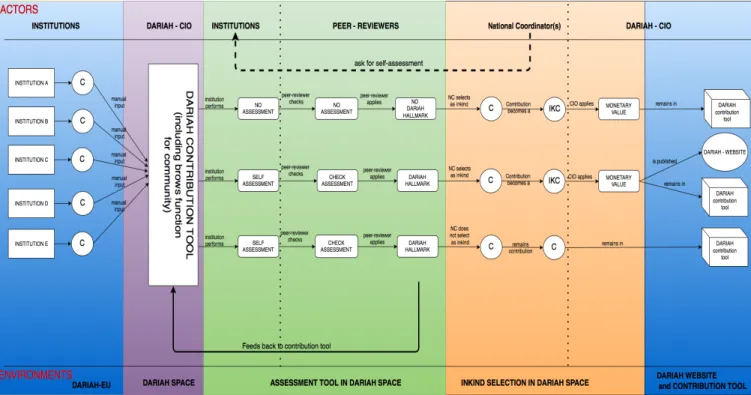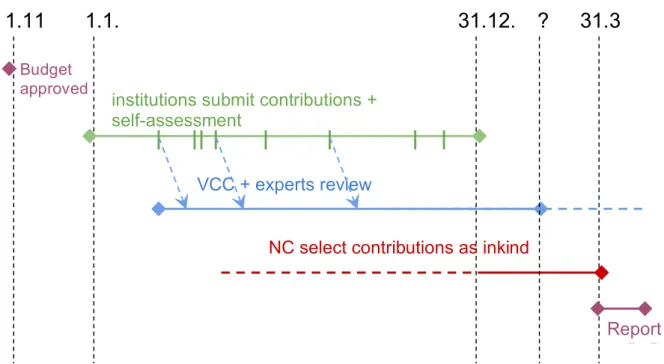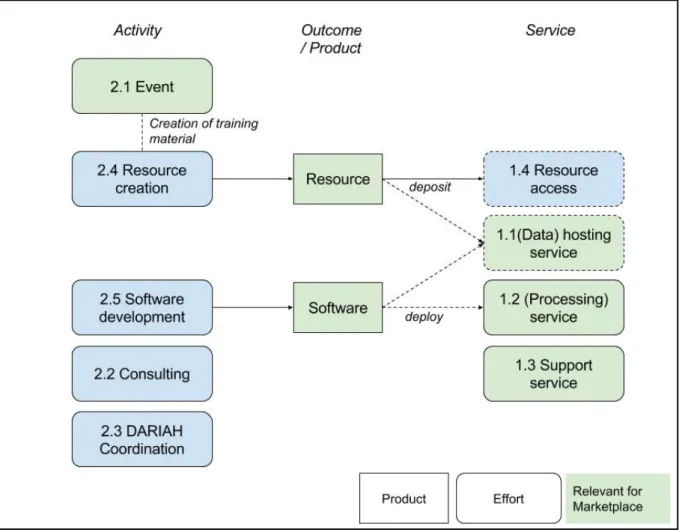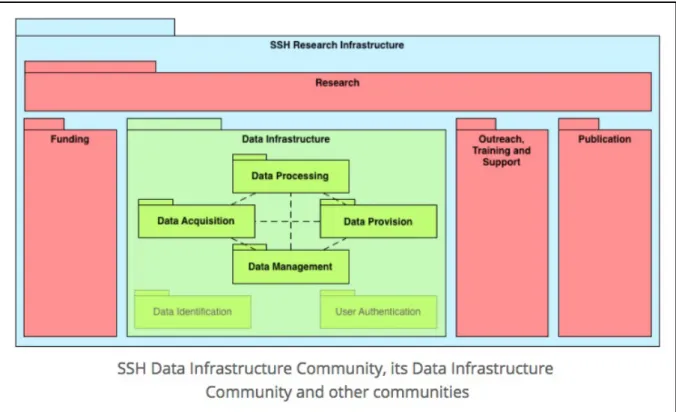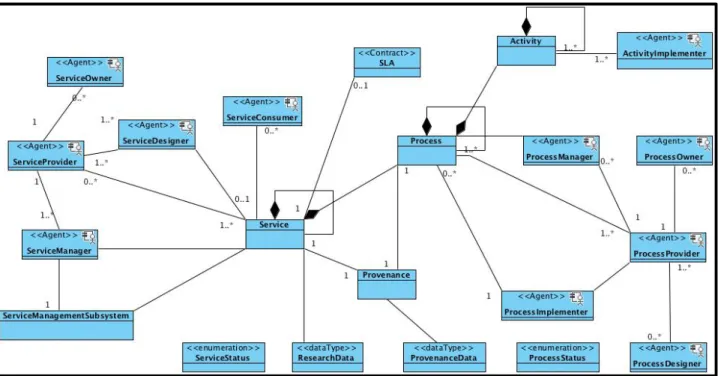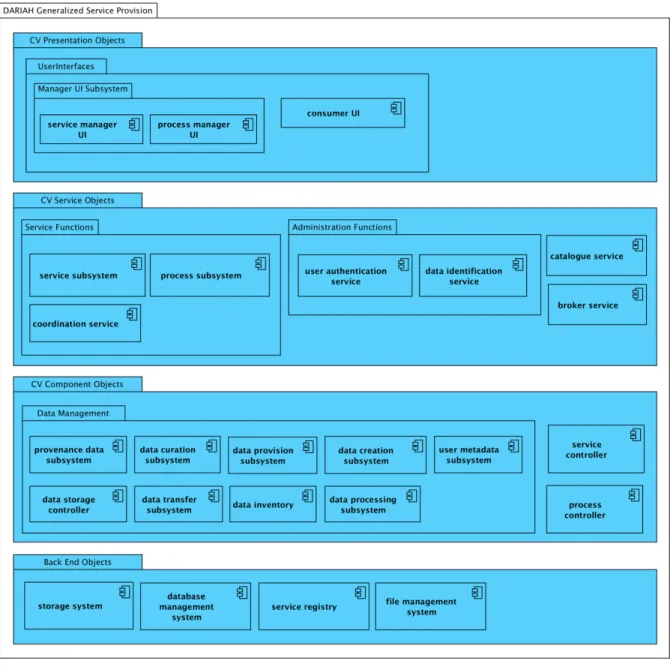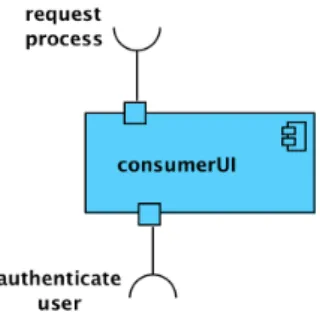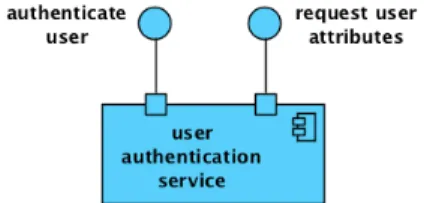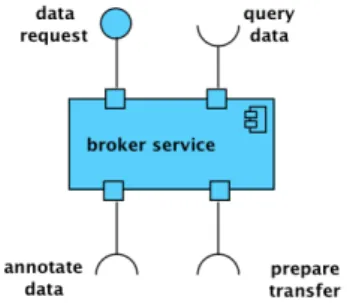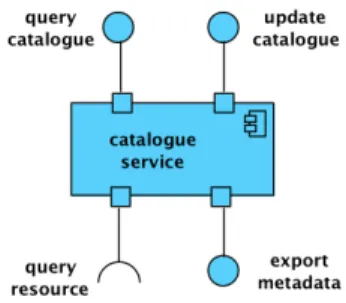HAL Id: hal-01628733
https://hal.archives-ouvertes.fr/hal-01628733v2
Submitted on 20 Dec 2017
HAL is a multi-disciplinary open access archive for the deposit and dissemination of sci- entific research documents, whether they are pub- lished or not. The documents may come from teaching and research institutions in France or abroad, or from public or private research centers.
L’archive ouverte pluridisciplinaire HAL, est destinée au dépôt et à la diffusion de documents scientifiques de niveau recherche, publiés ou non, émanant des établissements d’enseignement et de recherche français ou étrangers, des laboratoires publics ou privés.
D5.1 Report on Integrated Service!Needs: DARIAH (in kind) contributions - Concept and Procedures
Lisa de Leeuw, Femmy Admiraal, Matej Ďurčo, Nicolas Larousse, Michael Mertens, Francesca Morselli, Mike Priddy, Paulin Ribbe, Carsten Thiel, Lars
Wieneke
To cite this version:
Lisa de Leeuw, Femmy Admiraal, Matej Ďurčo, Nicolas Larousse, Michael Mertens, et al.. D5.1 Report on Integrated Service!Needs: DARIAH (in kind) contributions - Concept and Procedures.
[Other] DARIAH. 2017. �hal-01628733v2�
D5.1 Report on Integrated Service Needs:
DARIAH (in kind) contributions – Concept and Procedures
HaS-DARIAH
INFRADEV-3-2015-Individual implementation and operation of ESFRI projects Grant Agreement no.: 675570
Date: 20 December 2017 Version: 1.1
Project funded under the Horizon 2020 Programme
Grant Agreement no.: 675570
Programme: Horizon 2020
Project acronym: HaS-DARIAH
Project full title: Humanities at Scale: Evolving the DARIAH ERIC
Partners: KONINKLIJKE NEDERLANDSE AKADEMIE VAN WETENSCHAPPEN – KNAW DIGITAL RESEARCH INFRASTRUCTURE FOR THE ARTS AND HUMANITIES CENTRE NATIONAL DE LA RECHERCHE SCIENTIFIQUE
GEORG-AUGUST-UNIVERSITAET GOETTINGEN STIFTUNG OEFFENTLICHEN RECHTS
Topic: INFRADEV-3-2015
Project Start Date: 01-09-2015
Project Duration: 28 months
Title of the document: D 5.1 Report on Integrated Service Needs
Work Package title: Basic Services Cluster 1: Integrating and Scaling National DARIAH contributions
Estimated delivery date: 30-09-2017
Lead Beneficiary: KONINKLIJKE NEDERLANDSE AKADEMIE VAN WETENSCHAPPEN – KNAW
Author(s): Lisa de Leeuw [lisa.de.leeuw@dans.knaw.nl], Femmy Admiraal [femmy.admiraal@dans.knaw.nl], Matej Durco [Matej.Durco@oeaw.ac.at], Nicolas Larrousse [Nicolas.Larrousse@huma-num.fr], Mike Mertens [mike.mertens@dariah.eu], Francesca Morselli [francesca.morselli@dans.knaw.nl], Mike Priddy [mike.priddy@dans.knaw.nl], Paulin Ribbe [paulin.ribbe@huma-num.fr], Carsten Thiel [thiel@sub.uni-goettingen.de], Lars Wieneke [lars.wieneke@uni.lu]
Quality Assessor(s):
Matej Durco [Matej.Durco@oeaw.ac.at], Mike Mertens [mike.mertens@dariah.eu], Lars Wieneke [lars.wieneke@uni.lu]
Keywords: assessment, contributions, in kind, reference architecture, contribution types, DARIAH Hallmark, Services, Activities
Revision History
Version Date Author Beneficiaries Description
1.0 15-10-2017 HaS WP5 DANS, UGOE-SUB, CNRS, DARIAH
Final version to be approved by JRC and discussed in NCC and GA. Current version in use now can be found on the DARIAH-EU wiki:
in kind Contributions1
1.1 20-12-2017 HaS WP5 DANS, UGOE-SUB, CNRS, DARIAH
Updated fig 2 on page 12; amended date from 31/1 to 31/12.
Table of Content
Executive Summary ... 3
Goal ... 5
Introduction ... 5
Documentation ... 6
Stakeholders ... 7
Main Concepts ... 8
Overall Procedure for collecting, assessing and selecting contributions ... 10
Timeline for collection of the in kind contributions ... 11
Assessment process ... 12
About the DARIAH Hallmark (DHM) ... 13
Types of contributions ... 13
The DARIAH-EU reference architecture for national contributions ... 16
Mapping of current contribution types to the new contribution types ... 17
Core metadata for contribution ... 18
Assessment criteria per (sub) type ... 19
1. Services ... 19
Services - General Assessment Criteria ... 19
Services - Additional Type specific Assessment Criteria ... 24
2. Activities ... 31
Activities - Type specific Assessment Criteria ... 31
In kind contributions ... 38
Calculation of in kind contribution’s cost ... 38
The future of (in-kind) contributions within DARIAH ... 39
The DARIAH Strategic Action Plan (STRAPL) ... 39
Prognoses for basic upkeep costs of the contribution tool ... 40
Recommendations for further development ... 40
1 https://wiki.de.dariah.eu/display/DARIAH/In-kind+Contributions
Executive Summary
Within the DARIAH research infrastructure the need to collect, disseminate and monitor the contributions offered to the infrastructure has always been present. Work package 5 of the DARIAH Humanities at Scale (HaS) project has explored and described the activities and structure required to sustain these needs, resulting in the DARIAH contributions concept and procedure including a supporting online tool.
The contributions to the DARIAH infrastructure consist either of services, being repeatable actions, or activities, which have a more unique/ one-time character. They are collected for several reasons. First of all, dissemination to the Arts & Humanities (A&H) community; contributions offered to the infrastructure need to be visible to the users within the community, so they can be found and used. Secondly the compatibility of the contributions to the infrastructure; how compatible are the contributions to the infrastructure, how easily can they be (re)used and/or combined with other services and last but not least monitoring of the variety and maturity of contributions as it is essential for the strategic planning and future development of the infrastructure.
The HaS project has developed an online tool that supports the collection of the contribution so they can be disseminated to the community. The contributions will be visible in the online tool, which in time will feed into the ‘marketplace’ that DARIAH is developing. Next to the contributions, the DARIAH marketplace will give access to a wide range of information relevant to the A&H community.
Furthermore, the tool enables contributors to self-assess their contribution according to criteria provided by DARIAH in order to see how compatible their contribution is to the infrastructure. These self-assessments are then peer-reviewed, on the basis of trust, by reviewers appointed by the infrastructure, which – when approved - are given a score that results in one of three tiers of compatibility to the infrastructure.
Finally, the tool can produce real time reports to monitor the diversity and capability of offered contributions, which subsequently can be utilised in outlining next steps for the infrastructure and its evolution.
Nature of the deliverable
✓ R Document, report
DEM Demonstrator, pilot, prototype DEC Websites, patent fillings, videos, etc.
OTHER
Dissemination level
P Public
✓ CO Confidential only for members of the consortium (including the Commission Services) EU-RES Classified Information: RESTREINT UE (Commission Decision 2005/444/EC)
EU-CON Classified Information: CONFIDENTIEL UE (Commission Decision 2005/444/EC) EU-SEC Classified Information: SECRET UE (Commission Decision 2005/444/EC)
Disclaimer
The Humanities at Scale is project funded by the European Commission under the Horizon
2020 programme. This publication reflects the views only of the author, and the
Commission cannot be held responsible for any use which may be made of the
information contained therein.
Goal
To establish a DARIAH ecosystem, in order to make available, assess, and evaluate national (in kind) contributions to the DARIAH infrastructure by taking into account existing best practises and quality requirements.
DARIAH members can contribute to the DARIAH community with a diverse range of resources, services and activities. Through an online tool the contributions will be collected and disseminated. Furthermore, the contributions will be evaluated using a self- assessment and peer review process which verifies the compatibility of the service or activity to the infrastructure, therefore allowing researchers to find matching services and activities more easily. Additionally, the tool will also be used to collect, value and monitor national in-kind contributions.
Introduction
DARIAH is a network, a research infrastructure. It connects several hundreds of scholars and dozens of research facilities in currently 17 European countries, the DARIAH member countries. In addition, DARIAH has several cooperating partner institutions in non- member countries, and strong ties to many research projects across Europe. People in DARIAH provide digital tools and share data as well as know-how. They organize learning opportunities for digital research methods, like workshops and summer schools, and offer training materials for the Digital Humanities.
The DARIAH members have agreed to contribute to DARIAH-EU in cash and in kind (see
DARIAH ERIC statutes2Article 18).
DARIAH members can contribute to the DARIAH community with a diverse range of resources, services and activities. The Board of Directors has prepared Towards a Strategy
for DARIAH3as a guideline for DARIAH activities in the coming years. It articulates a core mission for DARIAH and sets out high-level principles and a series of priority areas for the next two years. It is important that contributions offered to DARIAH are compliant with the core mission and the high-level principles of DARIAH.
This document elaborates on the process and procedure for offering contributions to the DARIAH community, how contributions are assessed, and how they become in-kind contributions. It is based on work done by the former Chief Integration Officer (CIO) team (Henk Harmsen and Lisa de Leeuw) and Sophie David (former Senior Management Team member) as well as on the feedback received from the participants at the DARIAH
2 http://www.dariah.eu/library/general-documents.html
Paris meetings in November 2014, in particular from the National Coordinators Committee (NCC).
Work Package 5 in the Humanities at Scale (HaS) project has developed the concept further since, using input from the subsequent NCC and General Assembly (GA) meetings, as well as an analysis of the in-kind contributions gathered during 2015 and 2016.
Furthermore, the HaS project will develop an online tool to support and enforce the policy and process, as well as making the contributions more visible/ accessible to the DARIAH community and beyond.
At the end of the project, the maintenance of this policy and the online tool will be handed over to the DARIAH Coordination Office (DCO) to ensure sustainability.
Therefore, this document needs to be considered a ‘living document’, that represents the concepts and procedures at current stage. The DARIAH DCO will be responsible to keep it up-to-date by including any further developments in the future. Some suggestions for enhancements were already discussed in the various meetings, and are presented in the final section of this document The future of (in kind) contributions within DARIAH.
Besides serving as a deliverable for the HaS project, this document intends to provide a basis for:
A. DARIAH Partner Institutions providing a structured description of their individual contribution and thereby preparing the self-assessment of (in kind) contributions.
B. The Joint Research Committee (JRC) and other experts in the field on how to review the contributions in a concise manner.
C. National Coordinators in collecting and submitting the in kind contributions for their country.
D. Reporting to the DARIAH Board of directors, National Coordinators Committee and the General assembly.
Documentation
●
Types of in kind contribution v1.3 (v1.0). This document was approved by the SMT in May 2014 and is now an integral part of this document.
●
In kind contributions collected during 2015 and 2016.
● CoreTrustSeal4
●
CESSDA SaW: Reuse Readiness Criteria
54 CoreTrustSeal (10-10-2017): https://www.coretrustseal.org/
5 CESSDA SaW reuse readiness criteria (09-10-2017):
(https://docs.google.com/document/d/1otafwrmWO5oHE9Ju06tf3l_zzqS9FIfKMNrvhD7frcU/e dit#heading=h.axq57kkk08mh
●
Capability models: ITIL
6, FitSM
7, CMMI
8●
DASISH: Reference model for the social sciences and humanities
9●
E-ARK: A Maturity Model for Information Governance
10●
CoPoRI: In-kind contribution
11Stakeholders
Listing of involved parties and their respective kind of interaction with the online tool:
DARIAH all & broad audience
Catalogue & Visualisations via the DARIAH-EU website and the online contributions tool.
Partner Institution
Offer their contributions to DARIAH via the contributions tool in order to get exposure of their contributions in the DARIAH community.
Peer reviewers; include Virtual Competency Center (VCC) heads and Working group (WG) leaders.
View, assess, approve and/or reject self-assessed contributions via the contributions tool.
National Coordinator (NC)
(gathered in / represented by the National Coordinators Committee - NCC)
View, select and submit annual in kind contributions per country via the contributions tool.
Senior Management Team (SMT)
View, approve and/or reject in kind contributions per country.
General Assembly (GA)
View in kind contributions per country.
DARIAH Coordination Office (DCO)
Content management, maintenance and further development of the contributions tool through full back-office access in order to be able to (technically) assist in all stages of the process.
6 ITIL (09-10-2017): https://www.axelos.com/best-practice-solutions/itil
7 FiTSM (09-10-2017): http://fitsm.itemo.org/
8 CMMI (09-10-2017):
https://www.google.nl/url?sa=t&rct=j&q=&esrc=s&source=web&cd=1&cad=rja&uact=8&ved=0ah UKEwim5bez8sDNAhWHPxQKHRuxCU0QFggeMAA&url=http%3A%2F%2Fwww.sei.cmu.edu%2Frep orts%2F10tr034.pdf&usg=AFQjCNHiHbh7E77h9OX2oQJtkyIiNkM85Q
9 Reference model for the social sciences and humanities (09-10-2017):
https://sites.google.com/a/dans.knaw.nl/reference-model-for-ssh-data-infrastructure/home
10 A maturaty Model for Information Governance (10-10-2017): http://www.eark-
project.com/resources/project-deliverables/19-d71-e-ark-a-maturity-model-for-information- governance-initial-version
Main Concepts
Contribution Any relevant research output or activity a DARIAH partner submits as DARIAH-related work.
See
The types of contributions and assessment criteriaheading for typology and criteria.
In kind contribution (IKC)
A contribution selected by National Coordinator as in kind for a given member country and year.
In kind contributions are one type of support for non-profit organizations. Conversely to cash contributions, in kind contributions represent the provision of goods or services to an organisation by one of its members, valued in monetary terms according to rules agreed upon beforehand by the members of the organisation, and accounted for as part of the member’s contribution to the budget.
An in kind contribution can consist either of the direct provision of a tangible asset to the infrastructure or of expenditure incurred directly by the contributor, which benefits the infrastructure and satisfies its objections. They include goods, use of services and facilities, professional services or expertise in the form of staff time, provision of or access to equipment, special materials. They are regarded as necessary to carry out the tasks and achieve the goals commonly agreed by the members. They would have to be paid for if they were not provided by a member. From the point of view of DARIAH, in kind contributions represent a stream of revenue, though they are not monetary. In kind contributions are commonly used in RI consortia and may represent a large portion of the RI's revenue.
In kind donations build relationships within an organization as the provider can support the mission and programs without investing cash.
Self-assessment Contributions offered by DARIAH partners can be self-
assessed against pre-set criteria depending on the type of
contribution, which is then peer reviewed.
Assessment criteria Set of predefined criteria which are used to evaluate a contribution on their compatibility to the infrastructure.
The assessment criteria will be evaluated every year and must be agreed upon by the DARIAH Senior Management Team (SMT). A type of contribution can be assessed and reviewed through a set of assessment criteria, of which some are based on the CoreTrustSeal (CTS) guidelines
12. DARIAH Hallmark
(DHM)
A recognition of the fulfilment of given criteria for the contributions received after the peer review of the contributions self-assessment. The DARIAH Hallmark has various tiers showing the compatibility of a contribution to the infrastructure.
In Kind Contribution (IKC) Monetary Value
IKC are assigned a monetary value based on the annual costs incurred by the DARIAH partner offering the contribution. See below for the
calculation of in kind contribution's cost heading.
12 CTS guidelines (10-10-2017): https://www.coretrustseal.org/why-
Overall Procedure for collecting, assessing and selecting contributions
Figure 1: In kind Contributions collection, assessment and selection
As a first step in the process, the DARIAH partner institution (from now on ‘institution’) offers a contribution to the DARIAH community through the DARIAH online contribution tool (from now on ‘tool’) by providing a core set of basic information (core metadata).
This can be done at any moment in time.
Once the contribution is submitted, the institution may choose to fill in a self-assessment
and submit it via the tool. If needed the DARIAH National Coordinator (NC) could prompt
the institution but that will not be supported by the tool. The assessment criteria (see the
heading Types of contributions) are provided by the tool. Assessment criteria are offered
for each type of contribution. The overall score per contribution is an average of the
scores on the individual criteria. The average score will determine the tier of the DARIAH
Hallmark (DHM), as specified in the
Assessment process heading. If the submittinginstitutions chooses not to fill in a self-assessment, the contribution will not be awarded a
DARIAH Hallmark, but it may still be selected as an in-kind contribution (see below). Any
submitted self-assessment is peer reviewed by the appropriate peer review group via the
tool (each contribution type has a different reviewers pool), as specified under the
Assessment process heading. A DARIAH hallmark (DHM) is awarded according to thepositive review of the contribution. The results of the self-assessment, peer review and
related tier will be made public via the tool.
The National Coordinators select and submit the contributions they want to offer as in- kind contributions to DARIAH via the tool (see also the
Timeline for collection of the in kind contributions heading). NC’s will have access to the contributions and relatedmonetary value for their specific country.
The tool will generate real time reports on the in-kind status including monetary value per country for the Senior Management Team (SMT) and the members of the National Coordinators Committee (NCC). The Board of Directors (BoD) will present the results to the General Assembly.
Notes:
●
Submitting a self-assessment and going through the peer review is optional for the time-being and will become mandatory after a transition period.
●
Self-assessments and peer reviews can be done all year round.
●
Any changes to the contribution types and assessment criteria enter into force in the following calendar year.
Timeline for collection of the in kind contributions
In kind contributions for 2017 and further Period: 1st January 2017 – 31st December 2017
●
2016 – 1
stNovember: General Assembly; budget approval: cash and in kind (based on calculation as stated in the DARIAH statutes Article 18 – The contribution of each Member and each Observer shall consist of two parts. One part shall be the cash contribution and the other the in kind contribution. These two parts contribute to a percentage of the annual cash budget and the annual in kind budget of DARIAH ERIC, and shall be based on the GDP figures of each country)
●
2018 – 1
stof January: start of in kind submissions for 2017 by NC
●
2018 – 31
stMarch: Deadline for in kind submissions by NC
●
2018 – April: The Chief Integration Officer will send the in-kind contributions report
to the Board of Directors to be shared with National Coordinators Committee and
General Assembly.
Figure 2: collection of in kind contributions timeline
Assessment process
Institutes provide contributions to DARIAH-EU through the DARIAH contribution tool.
Contributions will be visible through the contribution tool and, if assessed and selected as in-kind contribution, also via the DARIAH website.
If an institute would like to get a DARIAH Hallmark for their contribution, they turn to the online system. For their type of contribution, the institute provides a score and explanation/evidence per assessment criterion via a self-assessment. A single contribution can be entered into the tool several times under a different contribution type and will then have to be assessed accordingly. The overall score per contribution is an average of the scores on the individual criteria. The average score will determine the tier of the DARIAH Hallmark (DHM). The DARIAH Hallmark is tiered to show the level of compatibility with the DARIAH infrastructure.
On completion, two peer reviewers review the explanations/evidence given by the institute. The first peer reviewer will be an expert from the field and the second reviewer is a Virtual Competency Centre (VCC) head. If the peer reviewers deem the explanations/evidence satisfactory, a hallmark is distributed that indicates the contributions compliance to the assessment criteria and in which tier. The VCC head has the final word when a conflict arises between the first and the second reviewer.
1.1. 31.12.
1.11 .
31.3 .
institutions submit contributions + self-assessment
VCC + experts review contributions
NC select contributions as inkind
Report to BoD Budget
approved
?
When the peer reviewers do not accept the institute’s entries and score for the assessment criteria, the institute will have the opportunity to amend their explanations until the peer reviewers are fully satisfied with the entries or finally refuse acceptance.
Peer reviewers will be drawn from a pool made up of Joint Research Committee (JRC) members, DARIAH working group participants, and experts from the field. Reviewers are assigned to a self-assessment by the back-office, who makes sure no conflict of interest will arise.
If the applicant raises an objection to the verdict of the two peer reviewers, escalation is possible. The self-assessment and peer reviewers’ verdict will be considered by selected members from the DARIAH Senior Management Team (SMT) and the DARIAH Scientific Advisory Board. If they agree with the peer reviewers the applicant will have to change his entry. If they disagree with the peer reviewers, the contribution is accepted and a DARIAH Hallmark is handed out to the contribution/applicant. The verdict of the DARIAH Senior Management Team (SMT) and the DARIAH Scientific Advisory Board is final.
About the DARIAH Hallmark (DHM)
The distributed DARIAH Hallmarks are valid for a limited time and are no longer valid after a maximum of 3 years depending on the funding period of the contribution. During this time, a contribution with DHM can be chosen as a national in kind contribution. In the months before the Hallmark expires the applicant will be contacted automatically and may decide to re-apply for a DHM to show that their contribution conforms to the most recent assessment criteria.
When a DHM has been distributed the assessment will be closed. When the DHM needs updating a new assessment should be initiated. A closed assessment cannot be changed or reopened.
Types of contributions
The contributions to DARIAH-EU will be assessed on their match/fit with the DARIAH infrastructure.
In order to assist and structure the assessment procedure, assessment criteria have been
developed for two types of contributions: Services and Activities, which in turn consist of
a number of sub-types. Services are repeatable actions, which will be disseminated to the
DARIAH community and beyond through the online tool and DARIAH website. Activities,
on the other hand, have a more unique/one-time character and will be available in the
online tool more for administrational/reporting purposes. Figure 3 shows how Activities
and Services relate to each other: It distinguishes between efforts and products - efforts being either Activities (with a limited duration) or Services (ongoing effort, no a priori duration set), products being either Resources (in the broad sense of research data) or Software. The stroked lines indicate the default (required) flow. Thus “2.4 Resource creation” activity leads to the existence of a “Resource” which needs to be made available through some kind of “1.4 Resource access”. The dashed lines indicate optional relations, e.g. an “2.1 Event” can be accompanied by creation of training material (“2.4 Resource creation”), the created training material being a Resource in its own right. Also, a software is already a product in its own right (very relevant for the Marketplace), but it could be optionally deployed as a “1.2 Service” and/or deposited at a “1.1 Hosting services”. The 1.1 and 1.4 services are similar in nature, both making resources available online, however 1.1 Hosting service offers this capability to third-party content providers, whereas 1.4 applies when the content provider publishes the resources with their own means. Hence also the optional path from resource to 1.1. Hosting service - the resource creator can decide to deposit the resource at an external hosting service. The diagram also indicates which aspects are potentially relevant for the “DARIAH Marketplace”, a platform on which tools and service relevant to the DARIAH community will be showcased (see The future of (in kind) contributions within DARIAH heading).
Figure 3: relationships between activities and services
The basis for developing the assessment criteria are the current assessment criteria in use by DARIAH, however, the following existing systems/models have also been consulted and/or partly re-used: Data Seal of Approval, Reuse readiness levels, Capability models (ITIL, CMMI, FitSM), alongside work done in the CESSDA-SaW and DASISH projects (see the Documentation heading).
Contributions made to DARIAH will be added to the online tool according to the subtypes described below as to facilitate submission and searching the contributions more easily.
Types of contribution Subtype Remarks
1. SERVICE (repeatable upon demand or continuous)
1.1. DATA HOSTING
SERVICE (IT based) e.g. hosting software or data.
1.2. PROCESSING SERVICE (IT based)
1.3. SUPPORT SERVICE
e.g helpdesk, software maintenance
1.4 ACCESS TO RESOURCES
e.g. educational resources, data resources… metadata creation & enrichment 2. ACTIVITY (one-time discrete
action)
2.1 EVENT
e.g. summer school, webinar, training
2.2 CONSULTING 2.3 DARIAH COORDINATION
2.4 RESOURCE CREATION
e.g. educational resources, data ...
2.5 SOFTWARE
DEVELOPMENT
The DARIAH-EU reference architecture for national contributions
In line with the division of the (in kind) contributions over services and activities, the HaS project has worked on a
reference architecture13for the submission of national contributions to DARIAH EU. This reference architecture further develops the definition and components by using a formal language, borrowed from the theoretical models used in ICT systems.
The main goals of the reference architecture are to:
1. Communicate and to describe contributions in a common language and to have a common understanding of what components should be described. The in kind contributions have never been formally described before, including their creation processes. The result is that up to now the contributions have been interpreted and labelled in different ways by each contributing country, by making the in kind contributions registry highly heterogeneous and unreliable from an end user perspective.
2. Facilitate the description of the interactions between components of the contributions, according to the services or functions they provide. How do the components of the contributions interact? How are they connected? What this reference architecture brings to life is not only a reliable description of the DARIAH contributions, but their description as processes and evolving systems, rather than immovable objects. It is therefore important to describe these changes and interactions with the environments in which the contributions evolve.
3. Offer an architectural reference for other projects and infrastructures that wish to offer similar services to their (research) communities.
4. Mitigate and reduce risks: we consider this reference architecture as a way to reduce the risk mainly derived from point 1: that of interpreting the (in kind) contributions in different ways, to describe them without a common reference model. This risk exists not only among partners inside the same research infrastructure but also for who accesses the DARIAH contributions from other infrastructures.
The DARIAH reference architecture for the national contributions is available as Annex 1 to this concept and procedure document and will also be made available via the DARIAH website.
13Reference architecture for a SSH infrastructure : https://sites.google.com/a/dans.knaw.nl/reference-model-for- ssh-data-infrastructure/part-1/introduction
Mapping of current contribution types to the new contribution types
Current in kind contribution types
New contribution types/subtypes
Remarks / conversion rules
Access 1.1. HOSTING SERVICES
1.4 ACCESS TO RESOURCES
Expertise 2.2 CONSULTING Contributions under this type are only applicable when there was actual activity. General statements of
available/potential expertise are not evaluable and won’t be accepted as contribution Interoperability 1.2. PROCESSING SERVICES
1.3. SUPPORT SERVICES Content Hosting 1.1. HOSTING SERVICES Tools and Software 2.5 DEVELOPMENT OF
SOFTWARE
Event 2.1 EVENT
Training 2.1 EVENT
Summer School 2.1 EVENT
Cooperation 2.3 DARIAH COORDINATION Educational
Resources
1.4 ACCESS TO RESOURCES 2.4 CREATING RESOURCES
Depending on contribution:
If giving access to -> 1.4 If creating resource -> 2.4 If both, then it is two separate contributions
Data 1.4 ACCESS TO RESOURCES
2.4 CREATING RESOURCES
Depending on contribution:
If giving access to -> 1.4 If creating resource -> 2.4 If both, then it is two separate contributions
DARIAH coordination 2.3 DARIAH COORDINATION
Others - Removed as a type
Core metadata for contribution
The following core metadata are required to be able to disseminate/discover the contributions made to DARIAH.
●
Identifier (created by tool)
●
Country
●
Submission date (submission of core metadata by contributor)
●
Assessment date (submission of review by reviewer)
●
Year (year of submission as in kind by NCC)
●
Contribution subtype (type is added automatically, derived from the subtype)
●
Title
●
Description in English (including project it originated from, if applicable)
●
URL to contribution
●
Contact institution name
●
Contact person name
●
Contact person email
●
Related contributions - arbitrary (typed?) links between contributions
●
“tags/keywords” (a simple folksonomy way to classify the contributions)
●
TADIRAH activities
●
TADIRAH objectives
●
TADIRAH techniques
●
Disciplines
●
Costs (see heading Calculation of in kind contribution’s cost)
Assessment criteria per (sub) type 1. Services
Services - General Assessment Criteria
●
Extra metadata:
○ Support Contact -> provide contact details (email address, or other means of soliciting support, like issue tracker, helpdesk, feedback form)
○ Underlying software. (If the software itself is being developed and maintained then it is a separate contribution: see heading
2.5 Software development)●
Maturity Level
Score Level Description 1 Ad hoc Proof of concept
2 Repeatable Best effort basis, could change or go offline
3 Managed running stable + commitment to support for extended period
●
Support Level
Score Level Description
0 None No defined way of support for users. Use as is.
2 Partial There is a defined Support Contact, but served on best-effort basis with no dedicated capacity
3 Comprehensive There is a defined Support Contact, with dedicated capacity to process support requests
●
Documentation available (in English, relates to the software underlying the service)
a. For the user (ideally as contextual help in the application or online) Score Level Description
0 None No usable user documentation available
2 Partial Some user documentation available, potentially not
complete or not fully up-to-date
3 Comprehensive Comprehensive up-to-date user documentation available (online or as contextual help in the application)
b. For the developer (inline in the code and/or comprehensive documentation of the system architecture, functions and APIs as part of the software package or online)
Score Level Description
0 None No usable developer documentation available
2 Partial Some documentation of the system, its APIs and architecture available, potentially not complete or not fully up-to-date 3 Comprehensive Comprehensive up-to-date developer documentation
available
c. For the administrator - installation, deployment, monitoring Score Level Description
0 None No usable documentation regarding installation, deployment or monitoring
2 Partial Some documentation for administrators available
3 Comprehensive Comprehensive up-to-date administrator documentation available
●
Multilingual User Interface in English (working language of DARIAH) and/or other languages, support for localisation, multi-script (allows to switching scripts in one input field) and right-to-left text (where applicable)
Score Level Description
0 None (Almost) no support for multilingual UI, localisation etc. UI text is hard-coded in the application and there is no simple way to change the language.
2 Partial Underlying software supports localisation / multilingual UI,
but the service is available only in one language; OR the localisation/multilingual support is not implemented systematically and may be difficult to extend to other languages.
3 Comprehensive Underlying software supports localisation / multilingual UI in a systematic manner (dictionary files), it is clearly defined and documented how to add further languages. (only applies if there is an UI)
Next to that the application also supports right-to-left text and multiple writing systems for the UI and for the input if applicable.
NA Not applicable Given the nature of the service there is no UI to translate (e.g. web service)
●
Is there an Impressum (+ Info on use of cookies)
& Terms of UseScore Level Description
0 None No, Impressum OR info on use of cookies missing
2 Complete Yes, Impressum, Terms of Use AND info on use of cookies present
NA Not applicable Given the nature of the service there is no Impressum or info on cookies to show (e.g. web service)
●
Services exposes an API - programmatic access to (read and write) data; typically, RESTful web service, OAI-PMH endpoint, Feeds, but also an option to call the service/application via URL passing data as parameter
Score Level Description
0 None no structured API exposed
2 Partial An API is available, but it is
experimental/incoherent/unstable, or the documentation is missing or incomplete
3 Comprehensive a well-documented standard-conforming (ideally RESTful) API offering read and possibly write access to data (or invocation of the service) available
NA Not applicable Given the nature of the service there is no programmatic
●
The service is monitored, (DARIAH services as in-kinds available) Note: When up-to-date status about the service up-time is exposed publicly, it is helpful information for the user, for the service provider (can act quickly upon downtime) and the infrastructure administration (gets overall picture of the status of the services constituting the infrastructure)
Score Level Description
0 None No automatic/systematic monitoring in place
2 Partial The service is being monitored automatically locally (either directly by service provider, or the corresponding computing centre or similar)
3 Comprehensive Monitored by DARIAH monitoring service:
(added value of being monitored by DARIAH is the sense of the service being part of one coherent infrastructure and an independent control instance)
●
User statistics (DARIAH services as in kinds available). Note: User statistics via DARIAH allow to view the service in the context of the bigger infrastructure.
Score Level Description
0 None No user statistics are being collected 2 Partial Own solution for user statistics
3 Comprehensive User statistics via DARIAH user statistic service
●
Service supports federated DARIAH login (Single-Sign-On, AAI via Shibboleth https://de.dariah.eu/en/aai), and/or via OpenID
Score Level Description
0 None No AAI (just local login)
2 Partial OpenID or Shibboleth login with DARIAH account OR some
institutional accounts possible, however comprehensive
coverage missing
3 Comprehensive Shibboleth (and/or OpenID) login possible with DARIAH account and any institutional account (in one of the eduGain countries)
NA Not applicable No login required
Services - Additional Type specific Assessment Criteria
1.1 Data hosting service
Hosting or deposition service, a repository, i.e. the ability and willingness of a provider (like a data centre) to store and (optionally) publish resources of other parties for a defined period of time.
Scope Note: This covers mainly traditional repositories for publications and research data, but also any other service that allows to store and publish resources of any kind.
This service is similar to 1.4 Resource access, with the distinction that in 1.1 access is offered to data from third parties, thus the provider offers only the means to store and publish resources, not the resources themselves.
Examples: HAL
14, Zenodo
15, NARCIS
16, OpenEdition
17Apart from taking responsibility for the contents it hosts, a platform may :
- Inform users or other platforms about the contents it hosts (via OAI-PMH for instance)
- Provide views of the contents. That is somehow, publish the contents.
- Provide interfaces for other platforms or tools to connect and access the contents - Manage mechanisms of access control
Assessment Criteria:
● Core metadata for contribution
● Services - General Assessment Criteria
●
There is help provided by the repository/platform describing what information is needed for others to assess the quality of the data, compliance with disciplinary and ethical norms and (alt)metrics about the use of the information.
[CoreTrustSeal-Requirement
184, 11 & 14]
Score Level Description 1 Theoretical
(initial)
We have a theoretical concept.
2 In progress
(partial)
We are in the implementation phase.
14 HAL (10-10-2017): https://hal.archives-ouvertes.fr/
15 ZENODO (10-10-2017): https://zenodo.org/
16 NARCIS (10-10-2017): https://www.narcis.nl/?Language=en
17 Open Edition (10-10-2017): https://www.openedition.org/?lang=en
18 CoreTrustSeal (CTS) requirements (10-10-2017): https://www.coretrustseal.org/why- certification/requirements/
3 Implemented (comprehensive)
This guideline has been fully implemented for the needs of our service.
●
There is a list of the formats accepted or promoted by the repository/platform. So that data producers are able to provide the data in formats recommended by the data repository. [CoreTrustSeal-Requirement
198]
Score Level Description 1 Theoretical
(initial)
We have a theoretical concept.
2 In progress
(partial)
We are in the implementation phase.
3 Implemented (comprehensive)
This guideline has been fully implemented for the needs of our service.
●
There is a description of the means the repository/platform uses to ensure compliance with legal regulations and contracts including, when applicable, regulations governing the protection of human subjects. [CoreTrustSeal-
Requirement202&4]
Score Level Description 1 Theoretical
(initial)
We have a theoretical concept.
2 In progress
(partial)
We are in the implementation phase.
3 Implemented (comprehensive)
This guideline has been fully implemented for the needs of our service.
19 CoreTrustSeal (CTS) requirements (10-10-2017): https://www.coretrustseal.org/why- certification/requirements/
20 CoreTrustSeal (CTS) requirements (10-10-2017): https://www.coretrustseal.org/why-
●
The processes and procedures for managing data storage are documented [CoreTrustSeal-Requirement
219]
Score Level Description 1 Theoretical
(initial)
We have a theoretical concept.
2 In progress
(partial)
We are in the implementation phase.
3 Implemented (comprehensive)
This guideline has been fully implemented for the needs of our service.
●
The ways provided for data re-users to discover and use the data and refer to them in a persistent way are provided. [CoreTrustSeal-Requirement
2211&13&14]
Score Level Description
0 None No search options nor PIDs provided.
2 Partial The UI either enables data search
or it offers a persistentway (PID) of referring to the data.
3 Comprehensive The UI enables data search and offers a persistent way (PID) of referring to the data as well.
●
Is the service quality formalised?
Score Level Description
0 None Not formalised
2 Partial Best effort
3 Comprehensive SLA available
21 CoreTrustSeal (CTS) requirements (10-10-2017): https://www.coretrustseal.org/why- certification/requirements/
22 CoreTrustSeal (CTS) requirements (10-10-2017): https://www.coretrustseal.org/why- certification/requirements/
Examples:
OpenEdition23
, HAL
24, EHRI
25, EASY (DANS)
26, NARCIS
27, GAMS Graz
28.
Cléo’s platforms (Calenda, Hypothèses, Revues.org, OpenEdition), hosting services for digitized content/assets.
1.2 Processing Service
A (digital) service that applies some algorithmic processing (statistical analysis, annotation) on given data, or provides means to edit/curate data (e.g. web interface for collaborative editing).
scopeNote: Processing service is distinct from content hosting service in that it does not store data, but generates new data based on given input.
Ideally, processing services are connected seamlessly with hosting service to appear to a user as one (virtual research) environment.
Assessment criteria:
● Core metadata for contribution
● Services - General Assessment Criteria
●
Provide sufficient information to assess the quality of the software, its compliance with disciplinary and ethical norms and (alt)metrics about the use of the information. [CoreTrustSeal-Requirement
294,11 &14]
Score Level Description 1 Theoretical
(initial)
We have a theoretical concept.
2 In progress
(partial)
We are in the implementation phase.
3 Implemented (comprehensive)
This guideline has been fully implemented for the needs of our service.
23 Open Edition (10-10-2017): https://www.openedition.org/?lang=en
24 HAL (10-10-2017): https://hal.archives-ouvertes.fr/
25 EHRI (10-10-2017): https://www.ehri-project.eu/
26 EASY: https://easy.dans.knaw.nl/ui/home
27 NARCIS (10-10-2017): https://www.narcis.nl/?Language=en
28 GAMS (10-10-2017): http://gams.uni-graz.at/context:gams
29 CoreTrustSeal (CTS) requirements (10-10-2017): https://www.coretrustseal.org/why-
●
Use due diligence to ensure compliance with legal regulations and contracts including, when applicable, regulations governing the protection of human subjects. [CoreTrustSeal-Requirement
302&4]
Score Level Description 1 Theoretical
(initial)
We have a theoretical concept.
2 In progress
(partial)
We are in the implementation phase.
3 Implemented (comprehensive)
This guideline has been fully implemented for the needs of our service.
Examples:
Conversion services (oxgarage
31), Digitisation/OCR, Stylometric analysis, Annotation &
Enrichment, Collaborative text editors (etherpad, wiki),
tokenEditor@ACDH-OEAW32, Enrichment
1.3 Support service
Support services support the use of a given service, e.g. through a helpdesk.
Assessment criteria:
● Core metadata for contribution
● Services - General Assessment Criteria
1.4 Access to resources
(Online) access to resources (datasets) offered by the content provider. This can be raw data, (web) applications offering rich access to data, or web services that allow a programmatic access to the data (API). The granularity of the described resources is up to the content provider, but we encourage a high-level description of whole coherent collections of resources.
scopeNote: This type of contribution does not include (national or domain-specific) aggregators, or metadata catalogues, i.e. services that collect information about resources from multiple providers and allow to browse and search in it. These will/can ideally become a source of information about contributions.
30 CoreTrustSeal (CTS) requirements (10-10-2017): https://www.coretrustseal.org/why- certification/requirements/
31 Oxgarage (10-10-2017): http://www.tei-c.org/oxgarage/
32 TokenEditor: https://www.oeaw.ac.at/acdh/tools/tokeneditor/
Neither it includes repositories, i.e. pure hosting services that offer storing and publication of data from third parties. (see 1.1. Data hosting service)
It also does not include web services processing data. (see Processing services contribution)
Assessment criteria:
● Core metadata for contribution
● Services - General Assessment Criteria
●
Provide sufficient information for others to assess the quality of the data, compliance with disciplinary and ethical norms and (alt)metrics about the use of the information. [CoreTrustSeal-Requirement
334, 11 & 14]
Score Level Description 1 Theoretical
(initial)
We have a theoretical concept.
2 In progress
(partial)
We are in the implementation phase.
3 Implemented (comprehensive)
This guideline has been fully implemented for the needs of our service.
●
Use due diligence to ensure compliance with legal regulations and contracts including, when applicable, regulations governing the protection of human subjects. [CoreTrustSeal-Requirement
342&4]
Score Level Description 1 Theoretical
(initial)
We have a theoretical concept.
2 In progress
(partial)
We are in the implementation phase.
3 Implemented (comprehensive)
This guideline has been fully implemented for the needs of our service.
33 CoreTrustSeal (CTS) requirements (10-10-2017): https://www.coretrustseal.org/why- certification/requirements/
34 CoreTrustSeal (CTS) requirements (10-10-2017): https://www.coretrustseal.org/why-
●
Enable the users to discover and use the data and refer to them in a persistent way. [CoreTrustSeal-Requirement
3511, 13 & 14]
Score Level Description 1 Theoretical
(initial)
We have a theoretical concept.
2 In progress
(partial)
We are in the implementation phase.
3 Implemented (comprehensive)
This guideline has been fully implemented for the needs of our service.
●
Terms of use, Availability, License Conditions of access to and reuse of the resource(s) are clearly indicated, and ideally support/encourage open access and reuse. If the resources (datasets) contain elements under different licenses the more restrictive license applies.
Score Level Description
0 None No license information available
2 Restricted License information available, but restricted license applies, that does not allow reuse.
3 Open License information available,
open and/or standard licences36that allows reuse.
35 CoreTrustSeal (CTS) requirements (10-10-2017): https://www.coretrustseal.org/why- certification/requirements/
36 Open Source Initiative (10-10-2017): https://opensource.org/licenses/category
2. Activities
Unlike the Services, Activities have no General assessment criteria, just subtype specific assessment criteria and /or extra meta data fields.
Activities - Type specific Assessment Criteria
2.1 Event
Events organised in the field of digital arts and humanities and cultural heritage, whose aim is to:
-
offer a theoretical insight of the methods, practices, history and future developments in the field of digital arts and humanities
-
showcase case studies in the field of digital arts and humanities
-
offer training and guidance in the application of digital methodologies in traditional humanities curricula
The duration of the event doesn’t represent a selection criteria: events of the duration of few hours (e.g. workshop) or few weeks (e.g. summer schools) can be submitted as DARIAH contributions, as long as they meet the requirements stated above.
Please note that English is the preferred working language for the events. While DARIAH recognises the importance of a multilingual development of the digital humanities, these DARIAH contributions represent nonetheless an invaluable resource for international researchers and institutions. The adoption of English during your event and its documentation, could help to disseminate your work among other communities.
Assessment criteria:
● Core metadata for contribution
●
Extra metadata:
○ Date of the event
○ Location of event
○ Duration of event
○ Number of participants at event
●
Documentation or report on targeted public is provided. Documentation includes:
○
An English version or abstract of the documentation
○
main discipline/ area of participants
○
level of expertise
○
Nationally/ Internationally oriented Score Level Description
1 Initial No information or report about the target audience has been
created and provided
2 Partial Partial information about the target audience has been created and provided
3 Complete The target audience has been fully documented and reported as part of the in-kind contribution
●
Documentation of the event is provided:
○
in English
○
Though a stable URL where the documentation is available
○
and can include: abstract, programme, slides, blogs etc.
Score Level Description
1 Initial No documentation of the event available
2 Partial Partial documentation of the event available online
3 Complete The event has been fully documented; it is fully available for reuse at a stable link
Examples:
Lecture, symposium, workshop, conferences, training day(s), summer/ spring/ winter school, academic course, academic program, MOOCs and other forms of online education
2.2 ConsultingExpertise that has been provided as a service to another DARIAH member or the DARIAH community. This may cover advice including consulting, audit, design or other activities where expertise forms the basis of the service. Transfer of knowledge activities should be only considered if they do not fit in the training categories (see headings
2.1 Event Training / Summer school or 2.4 Creating Resources).Assessment criteria:
● Core metadata for contribution
●
Extra metadata: If the project has been completed also indicate a targeted public (user, producer, repository manager, etc.) that could make use of the results in the future.
●
Indication of the consumer of the service:
○
Name of the corresponding institutions and their national affiliation,
○
Name of the contact persons OR DARIAH-EU including the name of a contact person
Score Level Description
1 Initial No or only very generic information is available
2 Partial Only partial information (e.g. only the name of an institution/national affiliation) is available
3 Complete All the required information is provided
●
If the contribution is still in process please provide a description of the existing results in English (summary, problem, table of content, content (type of formats, metadata, etc.) and draft the next steps as well as the final delivery date.
Score Level Description
1 Initial No or only very generic information is available
2 Partial Only partial information (e.g. only a summary) is available 3 Complete All the required information is provided
●
If the project has been completed provide the existing documentation/report about software, methods, etc., which should be in English or in English and any other relevant language(s), that specifies the results.
Score Level Description
1 Initial No or only very generic information is available 2 Partial Only partial information is available
3 Complete All the required information is provided
Examples:-
DARIAH.eu wants to assess the overall impact of IKC within the DARIAH community and asks DANS to perform this evaluation as well as to provide a final report.
-
The Austrian Academy of Sciences wants to implement a new single-sign-on solution and asks DAASI for advice on choosing the appropriate solution. The result of this consultation is documented in a final report
2.3 DARIAH Coordination / Cooperation
This type of contribution involves the coordination of DARIAH activities.
●
The different governance bodies of DARIAH
●
Central offices (DCO, CIO)
●
National Coordinator includes: national coordination at the financial, administrative or communication level done by the National Coordinating Institution
●
VCC Head
●
Working Group
●
Ambassadors
Assessment criteria:● Core metadata for contribution
2.4 Resource creation
The contribution is the creation of any kind of resource. This could be educational resources accompanying a training event, or digitisation of historic material. The outcome is a new resource (made available to the public as a service contribution 1.4.)
Examples for this type of contribution are:
-
Tutorials
-Guidelines
-
Teaching material
-
Software documentation (users)
-
bibliography or registries of digital humanities resources
-
New representation of existing historic material (cultural heritage objects)
-Structured metadata for resources
The new resources can be practically in any format, such as:
-
text (as a Word or PDF document)
-audio/video recording
-
interactive resources (e.g. quizzes, interactive maps and diagrams etc.)
-code
-
images
-
structured data (TEI, 3D-objects)
Please note that English is the preferred language for the contents of (educational) resources. While DARIAH recognises the importance of a multilingual development of the digital humanities, the DARIAH contribution represent nonetheless an invaluable resource for international researchers and institutions. The adoption of english for your training material could help to disseminate your work among communities.
Assessment criteria:
● Core metadata for contribution
●
Extra metadata field: Type of the Resource (e.g. video recordings; digitized
manuscripts)
●
English (verbose) description of the resource created (as opposed to structured metadata that could also include a verbose description):
○
context (organisational, research)
○
what research need it answers (motivation)
○
how the resource is organized and presented Score Level Description
0 None No description of the resource is provided 2 Partial Partial description of the resources is provided
3 Complete The description of the resource is fully provided and contextualised
●
Terms of use, Availability, License
Conditions of access to and reuse of the resource(s) are clearly indicated, and ideally support/encourage open access and reuse.
Score Level Description
0 None No licence information available 2 Partial Restricted license applies
3 Comprehensive License information available,
open and/or standard licences37are used that allow reuse.
●
A stable URL where the resource is available Score Level Description
0 None URL is not provided
2 Partial A link to the resource is provided, but the URL is not stable 3 Complete A stable URL is provided (PID, DOI)
●
Metadata about the resource is provided (in a structured format) Score Level Description
0 None No metadata available
2 Partial Metadata available just via web interface or in an unstructured format (word document, excel sheet)
3 Complete Metadata conforming to a metadata schema is publicly available and machine readable
2.5 Software development
Availability of software, i.e. executable code that can be installed and run by other partners. The contribution should include the source code (not just the binaries).
Scope Note: We distinguish between software and service as separate contributions.
Every (digital) service is an activation of some software. If both a service and the underlying software are provided, then it counts as two distinct (though related) contributions.
The code can be in any programming language, it can also be only a simple script dedicated to one specific task, as long as it is working and documented.
Assessment criteria:
● Core metadata for contribution
●
Terms of use, Availability, License Conditions of reuse of the software are clearly indicated, ideally open source licenses apply.
Score Level Description
0 None No licence information available 2 Partial Restricted licence applies
3 Comprehensive License information available,
open and/or standard licences38that allows reuse.
●
Code is maintained under version control (and available via a public repository) Score Level Description
0 None There is no defined way of code versioning and sharing with a broader audience
2 Partial a) There is a code repository with versioning, but it is not available to the public.
b) The source code (or just the executables) is shared online, but not via a code repository.
38 Open Source Initiative (10-10-2017): https://opensource.org/licenses/category
3 Complete The code is available via a public code repository (sourceforge, GitHub, etc.). It could be also institutional repository, but it needs to make the code available without restrictions.
●
Specification/Documentation available Score Level Description
0 None no (shareable) documentation of the application is available 2 Partial There is some documentation (either online or packaged with the
software), which can be incomplete, or partly outdated, but should contain at least somewhat useful information about the service
3 Complete There is comprehensive up to date documentation for users, developers and maintainers available (either online or packaged with the software)
●
Commitment level Score Level Description
0 None This is an abandoned/orphaned project, which still may be useful for someone to take up, but there is not really anybody to talk to about it.
2 Partial A prototype or a project, we may work on in the spare time, but (currently) don't have dedicated resources to commit to. Though there is someone knowledgeable of the code, who can be contacted by interested parties and might implement bug fixes.
And we are interested in cooperation on this.
3 Complete This is a critical piece of software for us, we (and others) use it actively, we have resources available to maintain and further develop. We have developers knowledgeable of the software available as contact persons.
Examples:
XSLT-scripts, Java applications, source code of web applications, software newly
developed for or during the digitization enrichment
In kind contributions
The DARIAH-ERIC states that the yearly country contribution to DARIAH is divided in a cash contribution and an in kind contribution. In kind is a specific effort made by a country in relation to and in accordance with DARIAH activities. In kind for a specific year are expenses that have occurred in that specific year, e.g. in kind offered for 2017, must be executed in 2017.
Next to the assessment procedure, the online system will also allow the National Coordinator (NC) to select and submit national in kind contributions. According to a calculation a value will be put on a contribution turning it into an in-kind contribution. If a contribution is selected as an in-kind and it has a DARIAH Hallmark it will be visualised on the DARIAH-EU website as a DARIAH service.
The budget for a certain year for in-kind contributions is set in November of the previous year as stated in the DARIAH-EU statutes (Article 18 and ANNEX II). The collection of the in-kind contributions will take place after the fiscal year has passed and is the report of the contributions realized in that fiscal year.
Calculation of in kind contribution’s cost
The cost of an in kind contribution will be calculated according to the annual costs
incurred by the provider for allowing access to keep the service and or activity up and
running. The amount of the contribution should be reported as actual costs according to
the accounting rules agreed upon by the members in the statutes or bylaws of the
organisation or they can be calculated according to H2020 project accounting rules. The
costs are entered into the system on a basis of trust and will not be submitted to an
audit. The value, or in other words the annual costs, is entered during the filling of the
core metadata of the contribution.
